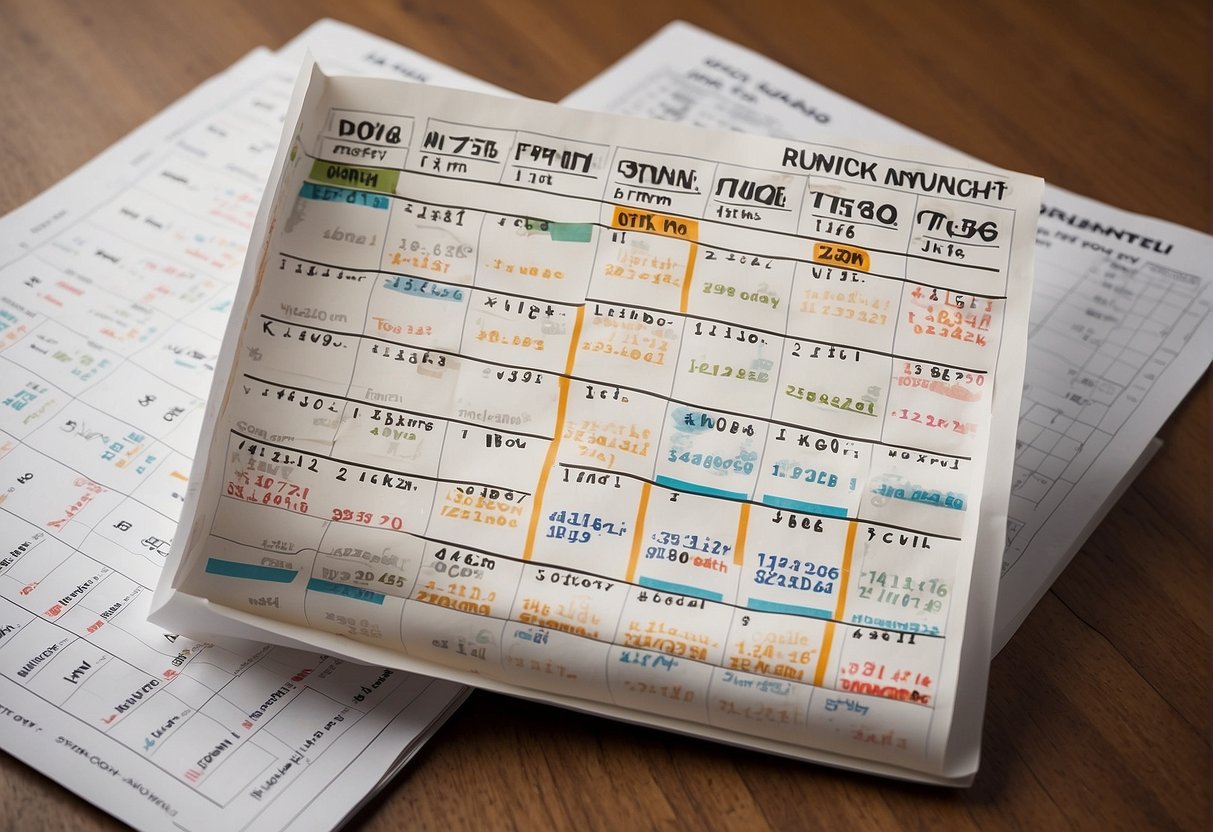Embarking on a six-week running plan is an effective strategy for improving their fitness and working toward weight loss goals. As we understand that weight loss is a gradual process, you need to set realistic goals that are achievable throughout the program. By gradually increasing the intensity and duration of runs, you ensure a progressive challenge to my body that can foster positive changes without causing burnout or injury.

One of the first things to consider in a weight loss journey is crafting a running plan that suits your current fitness level and personal schedule. Integrate running sessions with rest days and cross-training to optimize results and minimize the risk of injury. Alongside the running plan, pay close attention to nutrition, ensuring your diet supports your energy needs while creating a caloric deficit needed for weight loss. Throughout this period, please keep track of your progress, which helps to adjust the plan as needed and maintains your motivation by showing tangible results of your hard work.
Key Takeaways
- Realistic goal setting is crucial for a sustainable weight loss journey.
- An effective running plan includes cross-training and appropriate rest.
- Nutrition and progress tracking are essential to support weight loss efforts.
Quick Navigation
Quick Navigation
Setting Achievable Weight Loss Goals

When embarking on a 6-week running plan to shed extra pounds, it’s crucial to outline clear and attainable goals. These objectives should be tailored to your current fitness level and weight loss aspirations, ensuring a balance between challenge and practicality.
Defining Your Weight Loss and Running Targets
My weight loss goals are specific and measurable. Aim to lose 1 to 2 pounds per week, which is a safe and sustainable rate. This translates to a total weight loss target of 6 to 12 pounds over the 6 weeks. To achieve this, plan your running schedule to include a mix of long runs, interval training, and steady-paced jogs. For example:
- Week 1: Run 3 times (2 short runs at 20 minutes; 1 long run at 30 minutes)
- Week 2: Increment by 5 minutes for each run
- Week 3-6: Continue progressive increment and introduce interval training twice a week
Understanding Calorie Deficit for Weight Loss
You need to understand that to create a calorie deficit to lose body fat, especially stubborn belly fat. This means burning more calories than you take in. An estimated calorie deficit of 500 to 1,000 calories per day can result in a weight loss of 1 to 2 pounds per week. To track your progress, monitor your daily calorie intake and the calories burnt during my runs, aiming for the following targets:
- Daily Calorie Intake: Approximately 2000 calories for maintenance
- Caloric Expenditure from Running: Around 300-500 calories per run
- Adjusted Calorie Intake for Deficit: 1500-1700 calories
By combining my running routine with careful monitoring of caloric intake, I am setting a solid foundation for achieving my weight loss goals.
Crafting Your 6-Week Running Plan

When you set out to lose weight by running, you must create a 6-week running plan tailored to increase endurance and strength progressively. It’s designed to strike a balance between running, strength training, and recovery.
Week-by-Week Running Schedule
In your first week, establish a baseline with four easy runs, keeping pace comfortably. Each run should last between 15 to 20 minutes. Starting in week two, you should introduce a long run at a slow, steady pace, increasing the duration by 5 minutes each subsequent week. By the sixth week, your long runs extend to at least 40 minutes, which substantially boosts your endurance and calorie expenditure.
Incorporating Varied Running Workouts
From week three, include varied workouts such as intervals and tempo runs. For example, on Tuesdays, perform interval training—short bursts of high-intensity runs followed by recovery. Then, switch to a tempo run by Thursday, maintaining a challenging yet sustainable pace for 20 minutes. This variation ensures that your body adapts to different running demands.
Balancing Running with Strength Training
On Mondays and Fridays, incorporate strength training into your routine at least twice weekly. These sessions focus on the lower body and core, vital for a runner’s stability and power. Include exercises like squats, lunges, and planks. Strengthening your muscles aids in running efficiency and injury prevention.
Integrating Rest Days for Recovery
Recovery is paramount, so set aside Wednesdays and Sundays as rest days. This gives your muscles time to repair and grow stronger. Rest days also help prevent burnout and allow you to return to your next training session with renewed energy. You should find that adequate rest is as crucial as the training for a successful weight loss journey through running.
Nutrition and Diet for Runners

In my training experience, a focused nutrition strategy is crucial for weight loss and performance improvement. You should integrate specific foods for energy and optimize meal timing to aid recovery and sustenance.
Choosing Foods for Energy and Recovery
Select foods that contribute to sustained energy and facilitate the body’s recovery process. For energy, go-to sources are complex carbohydrates like whole grains, which steadily release glucose into the bloodstream, keeping your energy levels consistent during long runs. A quality diet should include lean proteins such as chicken, fish, and tofu to support muscle repair and recovery. Additionally, don’t overlook the importance of incorporating healthy fats from sources like avocados or nuts, which are vital for the body’s inflammatory response and overall health.
After exercise, focus on consuming a combination of protein and carbohydrates. This practice is essential for replenishing glycogen stores and rebuilding the muscles I’ve worked.
- Complex Carbohydrates: Whole grains, oatmeal, sweet potatoes
- Lean Proteins: Chicken breast, salmon, legumes
- Healthy Fats: Nuts, seeds, avocados
Meal Timing and Frequency
Timing and frequency of meals play an important role in managing calorie burn and maintaining energy levels. Typically, a preferred method is to spread your calorie intake over multiple small meals throughout the day, which helps manage hunger and keep my metabolism active.
Before a run, eat a light meal or snack high in carbohydrates and low in fat to provide a quick energy source without causing digestion issues. Post-run, aim to eat within 30 minutes to an hour to optimize recovery. This meal is more balanced, with an emphasis on proteins and carbohydrates to aid in muscle repair.
- Pre-Run: Light carbohydrate-rich snack, e.g., banana or a slice of toast with jam
- Post-Run: Balanced meal, including proteins and carbohydrates, e.g., a quinoa and chicken salad
By adhering strictly to my nutrition and meal plans, I support my body burns throughout the 6-week running program, ensuring progressive weight loss and improved fitness levels.
Tracking Your Progress

In my experience, the most substantial outcomes in any weight loss journey come from a tailored approach to monitoring change. I’ve learned this through successful strategies and common pitfalls runners encounter. Let’s explore how to keep track of your progress.
Monitoring Weight and Body Composition
Use a scale to document your current weight every week, knowing it’s just one aspect of your progress. Pay attention to body composition, including muscle mass and fat percentage, to paint a more comprehensive picture. Using body composition to monitor gives a better insight into the changes occurring in your body, ensuring they align with your training program.
Adjusting the Running Plan as Needed
As you gather data on your body weight and composition, be prepared to make informed adjustments to your running plan. If your body weight is plateauing or not shifting as expected, consider factors like training intensity, duration, and frequency. Perhaps it’s time for longer runs or increased interval training. Adjusting your plan is integral to continued progress and helps you stay aligned with your weight loss and fitness objectives.
Injury Prevention and Safety Tips

Incorporating appropriate measures to prevent injuries is essential to any weight loss running plan. To minimize the risk of injury and ensure safety, focus on proper running form and the selection of good running shoes, as well as consistent and thorough pre- and post-running routines.
Proper Running Form and Footwear
Proper running form is crucial to staying injury-free. To do this, maintain a neutral posture with a slight forward lean, ensuring your feet land directly under my body. This reduces the impact on your joints. Invest in good running shoes that match your gait and foot type to protect your feet and provide adequate support. Shoes with proper cushioning and arch support mitigate the risk of common overuse injuries.
Pre- and Post-Running Routines
Before you run, engage in dynamic stretches to prepare your muscles and joints for the activity ahead. Your routine should include leg swings and lunging hip flexor stretches to enhance your range of motion. Post-run, your cool down should include static stretches and foam rolling to aid your recovery. This routine will help you avoid injuries and contribute to your overall running performance.
Maintaining Motivation and Consistency

You’ll discover that maintaining motivation and consistency is vital in your journey to improve your health through a 6-week running plan. Your weight loss efforts hinge on sticking to your running routine, especially when it feels most challenging.
Setting Short-Term Milestones
Setting short-term milestones will keep you focused and on track. Aim for incremental increases in distance or time spent running each week, celebrating every additional minute or mile as a win! Whether it’s making it to the next street lamp without stopping or shaving seconds off your lap time, these small victories will fuel your determination to reach the finish line.
- Week 1: Run 5 minutes non-stop.
- Week 2: Run 8 minutes non-stop.
- Week 3: Run 12 minutes non-stop.
- Week 4: Complete a 20-minute jog.
- Week 5: Finish a 25-minute continuous run.
- Week 6: Run 30 minutes or prepare for race day.
Celebrating Your Successes
Make it a point to celebrate whenever you hit a milestone or have a particularly good day. It can be as simple as acknowledging your progress with a positive affirmation or treating yourself to a healthy reward like a post-run smoothie. These celebrations remind you why you started and give you the extra push to continue working towards your weight loss goals.
Frequently Asked Questions

In this section, I cover some common questions regarding a 6-week running plan for weight loss, focusing on what works and what beginners can expect.
What is the most effective running schedule for weight loss?
An effective running schedule includes varied-intensity workouts. Including high-intensity interval training sessions along with steady-pace runs can optimize fat loss and improve cardiovascular health.
How significant is weight loss when following a 6-week running plan?
Weight loss can be significant with consistency in a 6-week running plan, especially when combined with a balanced diet. However, the exact amount varies by individual and adherence.
For beginners, how should they start a running plan for weight loss?
Beginners should start slowly, focusing on duration rather than intensity to build endurance. Structured plans like Active Living Every Day give a good foundation for progressive training.
Are there any downloadable running plans available that are designed for weight loss?
Yes, many downloadable running plans are available online. Ultraprevention provides a 6-week plan geared toward improving health and weight loss.
Can a 4-week running plan be as effective for weight loss as a 6-week plan?
A 4-week plan can be a good start but may not yield the same results as a 6-week plan due to the shorter time frame. Consistency and gradual progression are key for weight loss.
What should one expect regarding weight loss after adhering to a running routine for 30 days?
After 30 days of a consistent running routine, one can expect a modest weight loss, improved running performance, and increased cardiovascular fitness. Results can be amplified with nutritional adjustments and increased training intensity.

